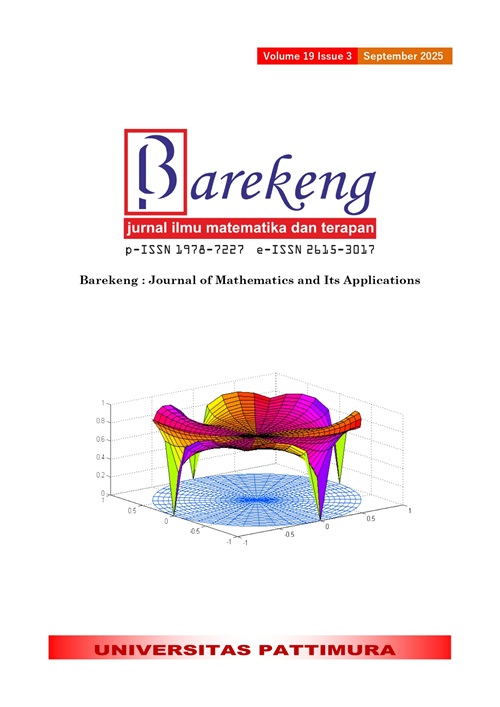PRICING OF THE ASIAN OPTION WITH THE KAMRAD-RITCHKEN’S TRINOMIAL MODEL
Abstract
Asian Option determines its payoff option value by the average stock during the option period. This research aims to determine the price of Asian Option by average arithmetic using Kamrad-Ritchken’s Trinomial method. The Kamrad-Ritchken trinomial model is one of the models in the trinomial method used to determine the option value that provides a procedure for determining the barrier parameter or stock price tendency ( ). The stock price tendency makes the trinomial model right on the dotted line of possible stock prices. This study is different from previous studies because the focus of this study is to determine the price of Asian options, both call options and put options with different maturity time variables. The data used for this research are taken from the NVIDIA Corporation (NVDA) data from August 2nd, 2021 – September 29th, 2023. Next, several parameters of option value are determined, which are the initial stock price ( ), contract price ( ), risk-free interest rate ( ), period ( ), stock return ( ), variance ( ), volatility ( ), stock price trend ( ), stock price increase ( ), stock price decrease ( ), stock price increase opportunity ( ), fixed stock price opportunity ( ), stock price decrease opportunity ( ), and barrier ( ). These parameters are used to calculate the price of Asian Option. According to the calculation result by average arithmetic using Kamrad Ritchken’s Trinomial method, the longer the maturity date of an option, the more expensive the option price will be.
Downloads
References
W. O. Irawan, M. Rosha, and D. Permana, “PENENTUAN HARGA OPSI DENGAN MODEL BLACK-SCHOLES MENGGUNAKAN METODE BEDA HINGGA CENTER TIME CENTER SPACE (CTCS),” Eksakta, vol. 18, no. 2, pp. 191–199, 2017.doi: https://doi.org/10.24036/eksakta/vol18-iss02/77
J. C. Hull, OPTIONS, FUTURE, AND OTHER DERIVATIVES, GLOBAL EDITION. New Jersey: New Jersey: Pearson Education, Inc, 2021.
M. N. Mooy, A. Rusgiyono, and R. Rahmawati, “PENENTUAN HARGA OPSI PUT DAN CALL TIPE EROPA TERHADAP SAHAM MENGGUNAKAN MODEL BLACK-SCHOLES,” J. Gaussian, vol. 6, no. 3, pp. 407–417, 2017, doi: https://doi.org/10.14710/j.gauss.6.3.407-417.
E. Wahyuni, R. Lestari, and M. Syafwan, “MODEL BLACK-SCHOLES OPSI CALL DAN OPSI PUT TIPE EROPA DENGAN DIVIDEN PADA KEADAAN CONSTANT MARKET,” J. Mat. UNAND, vol. 6, no. 2, pp. 43–49, 2017, doi: https://doi.org/10.25077/jmu.6.2.43-49.2017
W. Febrianti, “PENENTUAN HARGA OPSI DENGAN MODEL BLACK-SCHOLES MENGGUNALKAN METODE BEDA HINGGA FORWARD TIME CENTRAL SPACE,” J. Fundam. Math. Appl., vol. 1, no. 1, pp. 45–51, 2018, doi: https://doi.org/10.14710/jfma.v1i1.6
R. T. Vulandari and Sutrima, “BLACK-SCHOLES MODEL OF EUROPEAN CALL OPTION PRICING IN CONSTANT MARKET CONDITION,” Int. J. Comput. Sci. Appl. Math., vol. 6, no. 2, pp. 46–49, 2020.doi: https://doi.org/10.12962/j24775401.v6i2.5828
H. Xiaoping, G. Jiafeng, D. Tao, C. Lihua, and C. Jie, “PRICING OPTIONS BASED ON TRINOMIAL MARKOV TREE,” Discret. Dyn. Nat. Soc., vol. 2014, no. 1, pp. 1–7, 2014, doi: https://doi.org/10.1155/2014/624360
E. Rahmi, “TRINOMIAL MODEL ON EMPLOYEE STOCK OPTION VALUATION,” IOSR J. Math., vol. 13, no. 5, pp. 23–28, 2017, doi: 10.9790/5728-1305032328.
K. K. Langat, J. I. Mwaniki, and G. K. Kiprop, “PRICING OPTIONS USING TRINOMIAL LATTICE METHOD,” J. Financ. Econ., vol. 7, no. 3, pp. 81–87, 2019, doi: https://doi.org/10.12691/jfe-7-3-1.
C.-Y. Chiu, T.-S. Dai, Y.-D. Lyuu, L.-C. Liu, and Y.-T. Chen, “OPTION PRICING WITH THE CONTROL VARIATE TECHNIQUE BEYOND MONTE CARLO SIMULATION,” North Am. J. Econ. Financ., vol. 62, p. 101772, Nov. 2022, doi: https://doi.org/10.1016/j.najef.2022.101772.
S. B. Sitepu, D. C. Lesmana, and R. Budiarti, “PRICING EUROPEAN BASKET OPTION USING THE STANDARD MONTE CARLO AND ANTITHETIC VARIATES,” BAREKENG J. Math. Its Appl., vol. 17, no. 2, pp. 1007–1016, 2023, doi: https://doi.org/10.30598/barekengvol17iss2pp1007-1016.
I. Oktaviani, E. Sulistianingsih, and N. Satyahadewi, “PRICING OF CALL OPTIONS USING THE QUASI MONTE CARLO METHOD,” BAREKENG J. Math. Its Appl., vol. 17, no. 4, pp. 1949–1956, 2023, doi: https://doi.org/10.30598/barekengvol17iss4pp1949-1956.
J. Xiang and X. Wang, “QUASI-MONTE CARLO SIMULATION FOR AMERICAN OPTION SENSITIVITIES,” J. Comput. Appl. Math., vol. 413, p. 114268, Oct. 2022, doi: https://doi.org/10.1016/j.cam.2022.114268.
N. N. A. Artanadi, K. Dharmawan, and K. Jayanegara, “PENENTUAN HARGA OPSI BELI TIPE ASIA DENGAN METODE MONTE CARLO-CONTROL VARIATE,” E-Journal Mat., vol. 6, no. 1, pp. 29–36, 2017, doi: https://doi.org/10.24843/MTK.2017.v06.i01.p145
U. I. Lestari, E. Sulistianingsih, and N. Imro’ah, “PENENTUAN HARGA OPSI ASIA DENGAN RATA-RATA GEOMETRIK MELALUI PENDEKATAN BLACK-SCHOLES,” Bimaster Bul. Ilm. Mat. Stat. dan Ter., vol. 8, no. 2, pp. 239–246, 2019, doi: https://doi.org/10.26418/bbimst.v8i2.31862.
S. Sulastri, L. Novieyanti, and S. Sukono, “PENENTUAN HARGA OPSI BARRIER MENGGUNAKAN METODE TRINOMIAL KAMRAD-RITCHKEN DENGAN VOLATILITAS MODEL GARCH,” J. Ilmu Manaj. dan Bisnis, vol. 10, no. 1, pp. 83–91, 2019, doi: https://doi.org/10.17509/jimb.v10i1.16163.
B. Peng and F. Peng, “PRICING MAXIMUM-MINIMUM BIDIRECTIONAL OPTIONS IN TRINOMIAL CEV MODEL,” J. Econ. Financ. Adm. Sci., vol. 21, pp. 50–55, 2016, doi: http://dx.doi.org/10.1016/j.jefas.2016.06.001.
C. Dou, L. Wang, and C. Zhu, “THE EQUATION OF REAL OPTION VALUE UNDER TRINOMIAL TREE MODEL,” Open J. Soc. Sci., vol. 5, pp. 1–4, 2017, doi: https://doi.org/10.4236/jss.2017.53001.
S. Zhu, J. Zhang, and Z. Chen, “THE MAXIMUM AND MINIMUM PRICE IN TRINOMIAL MODEL,” in ICSEB ’21: Proceedings of the 2021 5th International Conference on Software and e-Business, 2021, pp. 104–106. doi: https://doi.org/10.1145/3507485.3507502.
D. Lilyana, B. Subartini, Riaman, and A. K. Supriatna, “CALCULATION OF CALL OPTION USING TRINOMIAL TREE METHOD AND BLACK-SCHOLES METHOD CASE STUDY OF MICROSOFT CORPORATION,” in Journal of Physics: Conference Series, 2021, pp. 1–7.doi: https://doi.org/10.1088/1742-6596/1722/1/012064
D. Josheski and M. Apostolov, “A REVIEW OF THE BINOMIAL AND TRINOMIAL MODELS FOR OPTION PRICING AND THEIR CONVERGENCE TO THE BLACK-SCHOLES MODEL DETERMINED OPTION PRICES,” Econom. Ekon. Adv. Appl. Data Anal., vol. 24, no. 2, pp. 53–85, 2020, doi: https://doi.org/10.15611/eada.2020.2.05.
A. Amalia, “PENENTUAN HARGA OPSI ASIA EROPA MENGGUNAKAN METODE TRINOMIAL KAMRAD RITCHKEN,” Universitas Pendidikan Indonesia, 2021.
S. Harwella, “PENGGUNAAN RATA-RATA ARITMETIKA DENGAN APPROKSIMASI CURRAN DALAM MENENTUKAN HARGA OPSI ASIA,” J. Mat. UNAND, vol. 3, no. 4, pp. 70–77, 2014, doi: https://doi.org/10.25077/jmu.3.4.70-77.2014.
J. Hartono, TEORI PORTOFOLIO DAN ANALISIS INVESTASI. Yogyakarta, Indonesia: BPFE, 2017.
Copyright (c) 2025 Jihan Nabila Wafa’, Emy Siswanah

This work is licensed under a Creative Commons Attribution-ShareAlike 4.0 International License.
Authors who publish with this Journal agree to the following terms:
- Author retain copyright and grant the journal right of first publication with the work simultaneously licensed under a creative commons attribution license that allow others to share the work within an acknowledgement of the work’s authorship and initial publication of this journal.
- Authors are able to enter into separate, additional contractual arrangement for the non-exclusive distribution of the journal’s published version of the work (e.g. acknowledgement of its initial publication in this journal).
- Authors are permitted and encouraged to post their work online (e.g. in institutional repositories or on their websites) prior to and during the submission process, as it can lead to productive exchanges, as well as earlier and greater citation of published works.






1.gif)



